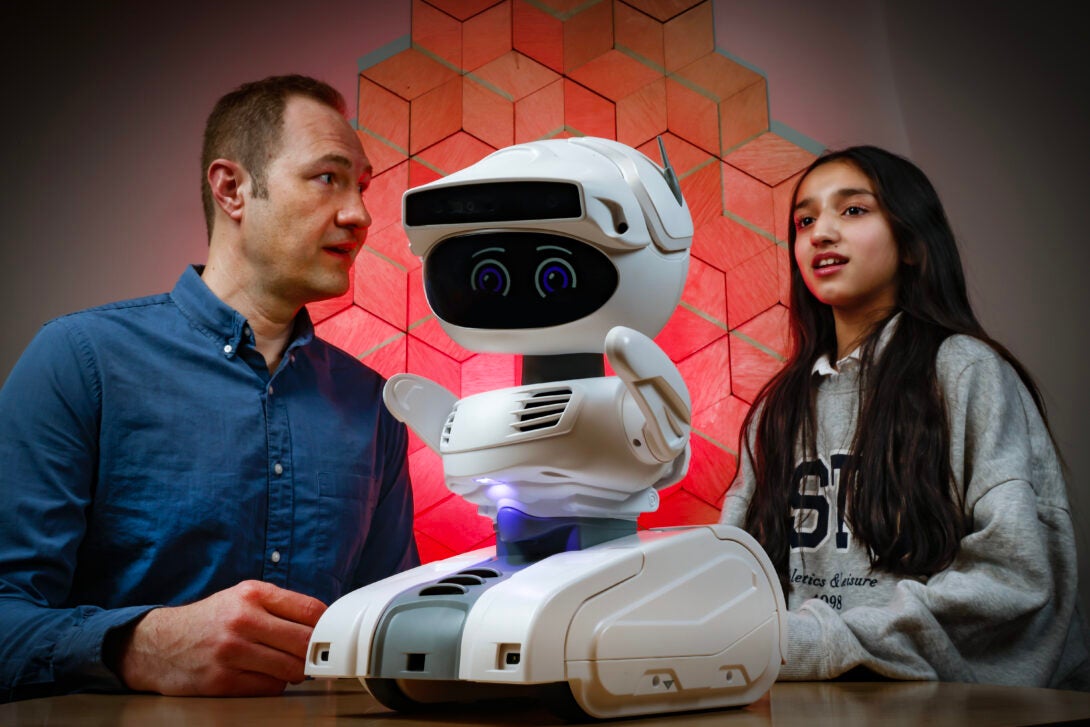Putting humans first in computer design
Computer Science faculty focused on human-computer interaction field
By Andrea Poet
text 1

When we navigate a website, interact with a touch screen, or don a virtual reality headset, we rely on the user interface for what we hope is a seamless, intuitive experience. It isn’t front of mind as a consumer to think about how that experience is designed, but we certainly notice when we are met with a maze-like login process or are stymied by multiple clicks to perform the simplest of tasks.
Human-computer interaction (HCI) is a design field that focuses on the design of computer technology, and the interactions between humans and computers. This can be technology used to improve learning for students, tools at the intersection of aging and accessibility, and creative endeavors. Each day, most of us participate in human-computer interaction, from smartphones to online banking and steaming services.
UIC has four researchers working in this area: Assistant Professor Debaleena Chattopadhyay, Professor Andruid Kerne, Assistant Professor Joseph E. Michaelis, and Assistant Professor Nikita Soni.
“We have the power to make unbelievable technologies but if we lose sight of the people that interface with those technologies, I think that we’re missing the point,” Michaelis said. “And that’s where my work really comes in.”
Removing frustrations
Michaelis started his career teaching middle- and high-school students, after obtaining a degree in philosophy. He then studied learning sciences and educational psychology, along with computer science.
“I’m really fascinated by people, so the HCI world allows me to do both of these things at the same time,” Michaelis said.
He has developed a social robot to assist students with their science homework, one that mimics the social interactions in the classroom and improves the home learning experience. The robot offers younger students a safe space to practice their work without judgment, whereas a similar interaction in a classroom can be terrifying to elementary school students. Older students also benefit, albeit in different ways. They don’t connect to the robot on the emotional level of younger students but can benefit from the social interaction of explaining their work, for example.
“We ask our students to go home and work by themselves, but they can really benefit from social interactions while learning,” Michaelis said. “That’s where a social robot can help.”
Getting the touch and feel right
Soni investigates how to design user interfaces for learning and creativity that go beyond a conventional mouse and keyboard approach, to allow both adults and children to interact using natural input methods such as touch and speech input, including multi-touch spherical displays for Earth Science education in museums and classrooms, and mobile interfaces for creative uses such as photo editing.
“Designing education technologies for kids is very different to adults, they are still growing cognitively and physically and don’t understand things like progress bars or use gestures in the same way as adult do,” Soni said.
She says her research is iterative, after developing a prototype she and her team watch how users are interacting with the tool and conceptualizing the material. They then integrate feedback into the final designs.
Soni’s multi-touch spherical display uses the same gestures used for manipulating information on a smartphone, and allows earth science and climate data to be displayed on a globe. The project, funded by the Illinois Space Consortium and sponsored by NASA, has been used in museums. Soni hopes to deploy the technology in classrooms later this year.
“The kids and families were so attracted to it. They were able to learn about climate change, the temperature change over time across geographic locations,” Soni said. “This data is usually displayed on flat screens.”
prof michaelis quote
We have the power to make unbelievable technologies but if we lose sight of the people that interface with those technologies, I think that we’re missing the point. And that’s where my work really comes in.
| Assistant professor of computer science
Text block 2

Improving accessibility and inclusivity
Chattopadhyay, a computer scientist turned HCI researcher, focuses on mobile technology, mid-air gesture input, virtual humans, and inclusive design.
Aging and accessibility is an area Chattopadhyay is very interested in. She said these groups of users are not always kept in mind as a target population for mainstream technologies. While the percentage of seniors using mobile phones is growing, they do not use all they have to offer. A lot of these features can be essential to living in 2023, especially the last few years, such as grocery delivery apps, or Covid-19 vaccination clinic sign-ups. To narrow the digital divide, she includes users from around the world in her research to ensure whatever is created is not just for people living in developed countries.
“No one wants to use an application or technology because somebody created it, they want to use it to achieve something,” Chattopadhyay said. “They want to use what you and I are using. They want to use it with their friends and grandchildren.”
Chattopadhyay is also developing a tool using AI avatars to assist in screening for PTSD among homeless and incarcerated women. She is working on this healthcare tool in collaboration with Rush University.
“It takes months to get a mental healthcare professional, so imagine the availability of mental healthcare for this underserved population,” Chattopadhyay said. “We are not trying to replace mental healthcare with AI, but this human-in-the-loop tool can mitigate the burden of mental health professionals with some initial screening.”
Bridging the gap between computers and artistic expression
Kerne has long straddled the creative and computational worlds. His background includes varied endeavors, from working as a senior software engineer in computer vision for NASA on the Mars Pathfinder project to spending a year in West Africa, studying traditional dancing and drumming, and working with Ghanaian artists on a piece for the Pan African Theater Festival.
He treats computing as a means of expression, focusing on creativity, play, participation, teaching and learning, and inclusion. Using design, sensory interface systems, AI, and algorithms, Kerne and his team develop tools, games, social networks, collections, installations, and performances that incorporate computation.
“Computing has always been a part of my life,” Kerne said. “Computing is not necessarily beneficial to humanity, but I want to believe that it can be. I made a commitment to myself that my involvement with computing will further that.”
These four HCI researchers are making advances in the field and teaching UIC students the importance of designing for the users of their technology. By putting humans first in the design process and creating technology with its users in mind, we can all benefit.
“I never thought of ‘users’ during my years of training as an engineer. I would build things—and that was it,” Chattopadhyay said. “Did anyone use it? How was their experience? Could their experience be better?”